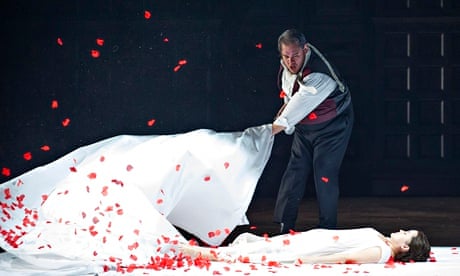In opera, age is relative. The teenage heroine is usually played by a soprano at least twice her age. The wise king whom you take to be in his dotage is only pushing 40. Productions can disguise their vintage too. Jonathan Miller's 1950s mafioso Rigoletto for English National Opera had grown whiskers yet still retained an air of raffish youth. All good things end. After three decades and a dozen revivals, the Duke's jukebox has been junked. On Thursday, Christopher Alden's new staging of Verdi's box-office hit ushered in a new era at the Coliseum.
On inspection, this "new" Rigoletto is already mature, having been seen in Toronto in 2011, and before that at the Lyric Opera, Chicago in 2000. As it's set in the mid-19th century – contemporary with the period Verdi wrote the work – it looks old too. Behaviourally, however, it spans all time: semi-nudity, suggestions of incest, an onstage hanging and what appears to be an orgy. The conservative Chicagoans hurriedly ditched it for a new production that no doubt looked even older – the opera's original setting is Renaissance Italy. In Canada the reviews were mixed.
Yet this Rigoletto is new to the UK, which is what counts. It is likely that London audiences, trained by ENO to expect dramaturgical adventure, will find more to enjoy in Alden's methods. There are many drawbacks and several clunks and confusions. But with so much thought and intelligence in evidence, this ugly, gutsy, melodrama, after Victor Hugo's play Le roi s'amuse, draws you in. Significantly there were no boos on first night, refreshing in itself.
In the annals of convoluted opera plots, that of the hunchback jester whose attempt at revenge ends in self-inflicted tragedy is straightforward. Verdi sympathised with his anti-hero and warmed, as ever, to the potential offered by the central father-daughter relationship, which here goes beyond mere paternal to near perverse: the wretched hunchback's obsessive love for Gilda hints at violence as well as desire. While his music explodes with all too human anguish, his brutal nature, superbly portrayed by the Hawaiian baritone Quinn Kelsey, is repellent. His boorish, tortured performance, together with a voice rich and secure from bottom to high top, is incomparable.
Alden has assumed his audience will know the story already. The settings of each scene – ducal palace, blind alley, deserted riverbank – are usually integral to the drama, and to the bold, shifting colours of Verdi's 1851 score, the first masterpiece of his maturity. It will take a while, maybe forever, to eradicate the crystal clear guidance provided by Miller's staging. Instead Alden's designer, Michael Levine, has provided a single, handsome fixed set. All takes place in the library-salon of a Victorian men's club: wood panels, potted palms, padded armchairs, newspapers to hide behind, a sense of quiet decay, spent debauchery and stale (electric) cigars. There is no river, barely a storm, no sack for the assassin's victim. Without these, the melodrama pales but the human interrelationships intensify.
Women have no place, unless they happen to be hysterical or nymphomaniacal. At the start, a girl writhes crazily, mad hair, white camisole. One such is locked in the attic of every mid-Victorian painting or novel. Later she is revealed as Count Monterone's daughter, a victim of the philandering duke. Gilda, the jester's precious daughter, will soon follow, in her own white camisole. Male solidarity is pushed to its furthest point: the courtiers scrum around the Duke to hide his love crimes, closing in a ring around him and punching the air at the crucial moment like spectators at a cock fight.
Mostly the singing was excellent. Barry Banks, as the Duke (they might have found him a better wig), pings and soars on all those top notes, and sang La donna è mobile – rendered in James Fenton's ingenious, vintage translation as "Women are changeable" – with precisely the right degree of infuriating insouciance. Peter Rose's Sparafucile was a scarily avuncular assassin, Justina Gringyte raunchy and scheming as his sister Maddalena. David Stout provided a malevolent presence as Monterone. Diana Montague imbued the near-silent Giovanna with dark ambiguity. The American soprano Anna Christy, as Gilda, sounded nervous in Act One, and while she grew in confidence, she lacks that usual fragility which elicits our sympathies. Or perhaps this is Alden's point: the women barely matter here at all except, grim thought, as objects of men's desire.
After some rough ensemble, the chorus – on stage most of the time – was impressive. The orchestra, from the opening brass solos onwards, responded energetically to Graeme Jenkins's brisk, well-nuanced conducting. Some of the stage pictures are stunning, especially at the end, when the room is bare, backlit as if to suggest the misty river beyond, only a body on the floor beneath a white sheet, spattered with red petals. As the opera reminds us, no spell is more evil than the one we cast on ourselves. Quinn Kelsey's cry of anguish at this realisation, slumped alone with his clown's hat and his grief, is already erasing memories of that darned jukebox.

Comments (…)
Sign in or create your Guardian account to join the discussion